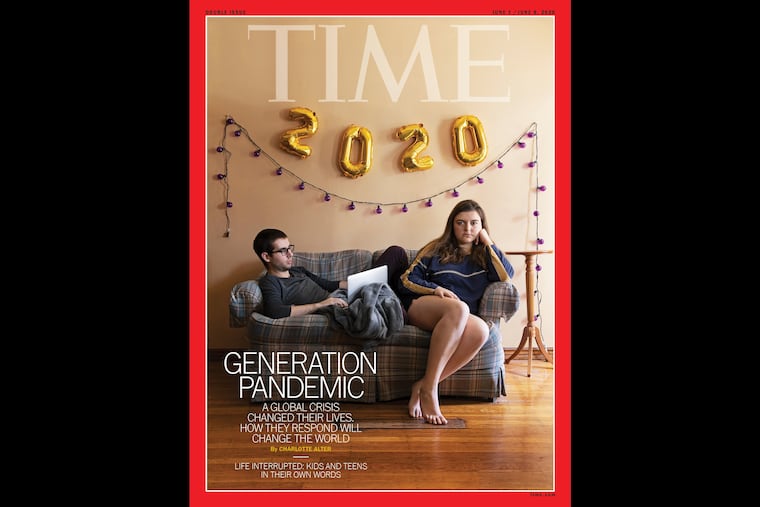How a Philly 23-year-old photographed a Time magazine cover without leaving her home
Hannah Beier is a photography student who has never had her work published professionally — until now, the cover of Time.

It’s an image built to become an icon. A sullen and barefoot woman, looking into the camera, with a young man sitting next to her staring deep into his laptop, both lounging on a tiny couch underneath a string of lights and crumpled gold balloons that spell out “2-0-2-0.”
The words GENERATION PANDEMIC are emblazoned on top of them.
The image graces the cover of the early June edition of Time, and was shot by a 23-year-old Drexel University senior, herself a member of that graduating class, who directed the portrait without leaving the Fort Washington home where she’s quarantined.
Hannah Beier has never before had a photo published professionally. She studies photography at Drexel — and is expected to graduate, albeit virtually, in June — and focuses on portraits that evoke the emotions of herself and her friends. She never imagined her first published image would be the cover of one of America’s most iconic magazines.
“It’s not what I imagined it to be, for sure,” Beier said of her senior year of college, “but something so incredible has come out of it.”
In addition to the cover, Time published a handful of similar images Beier created depicting young people quarantined in their homes. One shows a woman on a bed in Philadelphia, her boyfriend sitting behind her wearing big headphones and working on a computer. Another shows a woman in a sparkly jumpsuit, alone in a kitchen with a pink cake in front of her and the words happy birthday hanging above. A third shows two students on a porch, one strumming a guitar and the other lounging in a sweatshirt.
All the images were created over the last month — the cover image was shot within the last week — and Beier didn’t physically push a shutter to capture any of them.
Instead, each image was made through an hours-long process that involved Beier’s interviewing the subjects and then getting a tour of their space via FaceTime. She and each subject conceptualized the image together, and she directed the subject how to pose, how to set up the camera, and what settings to select. Then, the subject placed a phone or laptop behind the camera with FaceTime running, so that Beier could see the frame and get as close as possible to operating the camera herself.
Then they reposed, reframed, and reshot, over and over again. And there were plenty of times Beier wanted to jump through the computer screen and photograph the person herself.
“It’s like, I’ll see something and know how it should look, and I know if I was there I could capture it in two seconds,” she said. “What’s so amazing is, if it takes two seconds or two hours, we still get there. These photos are exactly how I would take them.”
» READ MORE: Let the virtual graduations commence: Coronavirus has pushed ceremonies online
Beier has gone through this process 30 or 40 times since she and her friends began quarantining in their homes. The images are part of her senior thesis, a project that was initially going to be about photographing important relationships in her life, but one that grew into documenting a pandemic.
Earlier this month, Time went on the hunt for photos of the generation graduating this year. One of Beier’s professors sent in her images, and she began working with Time about a week and a half ago, she said.
When Beier got the call that her photos would be published in the magazine, she screamed — her parents thought she’d had a disproportionate reaction to the reality TV show they were watching.
Instead, it was the sound of opportunity.
“I have never cried happy tears before. I cried happy tears that night,” she said. “That was the first time that I have been so overwhelmed, just with joy and gratitude for this opportunity.”